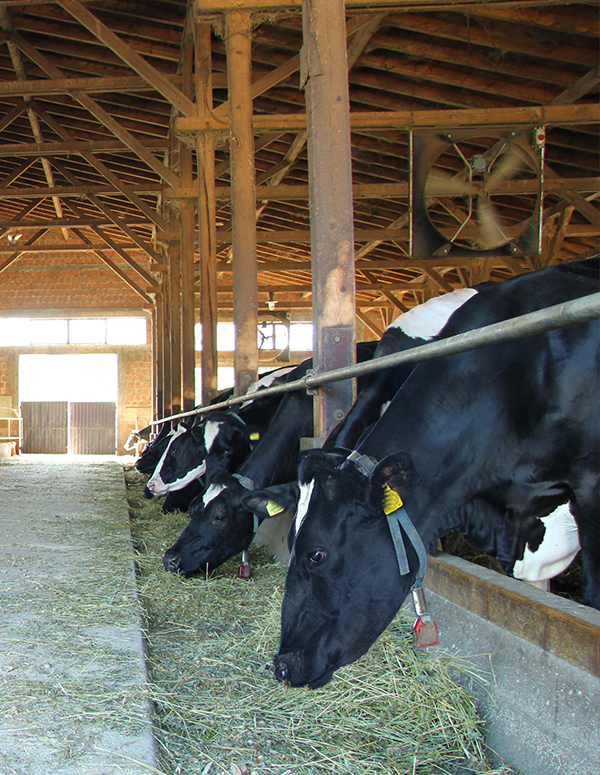After the brutally cold, long winter we’ve all just experienced, I don’t think anyone is worried about a little warm weather this summer. Actually, with the rainy and chilly spring, I’m sure most folks are still thinking more about mud and flood season right now. However, this is the time to start thinking about heat stress in your herd and heat abatement techniques that will keep your cows healthy and productive through the hot months ahead. In just a few short months, the full force of summer’s heat and humidity will be upon us, and you’re going to want to be ready.
Cows, especially the current genetic strains of today’s breeds, are very susceptible to heat stress. Recent research out of the University of Arizona demonstrates that high-yielding cows have a lower threshold for heat stress in terms of dealing with summer temperatures and humidity. When looking at Temperature Humidity Indexes (THI), it’s important to remember that our current cattle breeds have a lower THI limit. Dr. Zimmerman of the Balchem Corporation states that cows will begin to be affected by as few as 4 points lower on the THI. This means that our cows begin feeling the heat not only long before we do, but even sooner than cattle breeds did historically.
 So what exactly is heat stress and how do we spot it, and more importantly, how do we avoid it? “Cows in hot environments tend to have elevated body temperatures, higher respiration rates, and increased levels of electrolyte loss,” Zimmerman writes. Most folks who live in the Northeast don’t consider themselves in a “hot environment,” but considering that when temperatures move into the 70s (Fahrenheit), cows are already moving into heat stress. As Akey, the producer of I.C.E. (a heat abatement nutritional supplement) states, “When cattle are subjected to excessive heat their bodies respond by initiating physiological changes in order to dissipate the excess heat load.” Tom Bailey et al. from Elanco have published an aid for heat stress entitled, “Mechanics of Heat Abatement.” In it Bailey states that the TMI threshold for reproducing cows is 65, and is 68 for milk production. The Northeast and Canada can reach those temperatures without even, well, breaking a sweat.
So what exactly is heat stress and how do we spot it, and more importantly, how do we avoid it? “Cows in hot environments tend to have elevated body temperatures, higher respiration rates, and increased levels of electrolyte loss,” Zimmerman writes. Most folks who live in the Northeast don’t consider themselves in a “hot environment,” but considering that when temperatures move into the 70s (Fahrenheit), cows are already moving into heat stress. As Akey, the producer of I.C.E. (a heat abatement nutritional supplement) states, “When cattle are subjected to excessive heat their bodies respond by initiating physiological changes in order to dissipate the excess heat load.” Tom Bailey et al. from Elanco have published an aid for heat stress entitled, “Mechanics of Heat Abatement.” In it Bailey states that the TMI threshold for reproducing cows is 65, and is 68 for milk production. The Northeast and Canada can reach those temperatures without even, well, breaking a sweat.
What does this mean exactly? When a cow begins to enter into a heat stress situation, its body will react in ways to try and cool the animal, or keep it from overheating. Besides concern for the animal’s overall health, it means reduced milk production, increased probability of early embryonic death, reduced estrus, mastitis, lameness, and weakened immune system, just to name a few problems. Zimmerman points out that if any of the following points are true, your herd is heat stressed and needs extra cooling immediately: if more than 70–80% of your cows have rectal temperatures over 102.5°F, or breathing rate is over 80 breaths/minute (cows normally don’t pant), or dry matter intake or milk production drops 10% or more.
So how do you avoid heat stress in your herd? Unfortunately, there is no single silver bullet answer. There are, however, a few main techniques and methodologies for cooling cows that can get will you through the summer months. To be most effective you want to use a combination of tactics to battle heat stress, focusing your heat abatement strategy on these areas: Shade, Air, Water, and Nutrition.
In “Mechanics of Heat Mechanics” Bailey writes, “When implementing a cow cooling system, it is important to consider your location with the most immediate areas of need.” Heat abatement is a large task, and the cost could be significant in overhauling your current system, so prioritize where you can make the most impact first, and then work from there. In order of priority, Bailey recommends the following order: holding pens, maternity pens, prefresh cow pen, lactating cows—feed lines and free stalls, hospital cow pen, processing areas, and travel lanes. These targeted areas can be abated using shade, fans, or water 18 Perspectives Magazine phoenixfeeds.net/magazine sprinklers, or a combination of any of the three, depending on cost and need.
Let’s break down the techniques and define each of the four methodologies starting with Shade. Shade is the simplest and possibly the most cost-effective to implement. For best results, Bailey et al recommend using solid shade materials, or at least 90% blocking shade cloth. Providing shade in open lot or pastures, free lanes, free stalls, and holding pens allows cows egress from direct sunlight and a place to cool off. Shade alone won’t prevent heat stress in your herd, but, combined with these other methods, will help mitigate the issue.
The next abatement is Air. In hot environments, fans are essential to maximize ventilation and airflow. Fans should be a priority in free stalls over the feed lanes. It is important to note that combining water with fans is significantly more effective than just fans alone. However, water without fans can lead to increased humidity in your barns, which in turn can actually increase the likelihood of heat stress by creating a sauna-like atmosphere.
Water is the next abatement area. Water serves a dual role, both for drinking and soaking. First, providing fresh, clean drinking water is essential. Increasing the number of water sources so animals have multiple water locations is also suggested. There should be a minimum of two water locations per group; also consider water locations along exit lanes, holding pens, and at the exit of the milling parlor. Keeping your animals hydrated will significantly help in keeping heat stress at bay. You can use water in sprinklers over your animals. By wetting the animals’ backs, but not wetting them enough to wet their udders, and allowing the water to then evaporate, will lower the animals’ body temperature. By putting sprinklers over feed lines and holding pens, you can keep the animals cool during these higher temperature events and areas as well.
Your fourth abatement methodology is Nutrition. Hot and stressed cows eat less. It’s a fact, so to battle this you need to increase frequency of feeding. Making sure fresh feed is available during early morning and evenings, when temperatures are cooler, will also increase consumption. Because of reduced intake, it is important to maximize what is in the feed your cows are consuming. Zimmerman encourages increased “nutrient density of the diet” by supplementing key nutrients or ingredients which can help prevent heat stress. By increasing the amount of energy rations in the form of fat, protein, minerals, yeast culture, and products especially formulated to stave off heat stress, such as NiaShure, I.C.E., and Celmanax, your herd’s diet will nutritionally fortify it from increased temperatures and humidity.
Even though the skies are still gray and the mountains are covered in clouds, summer is coming. Temperatures and precipitation aren’t doing much to herald its approach, but we all know July and August can be tough. It’s better to be thinking about it now—and better to be prepared—than dealing with stressed animals and lower production. We can hope for nice pleasant summer weather, but we all know by now that we’ll get what we get, and have to deal with it.
This article first appeared in Perspectives Magazine Summer 2014 issue.

